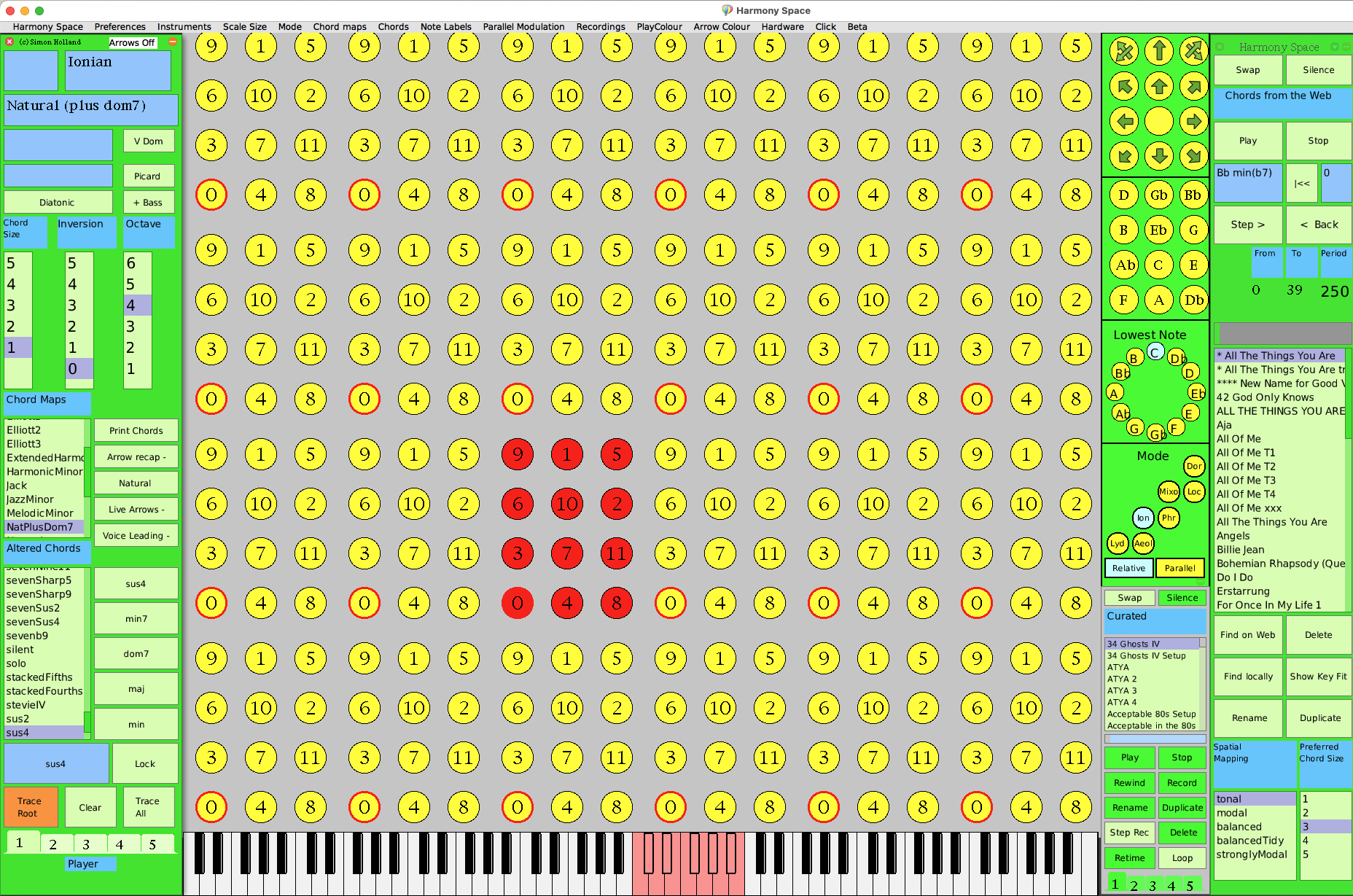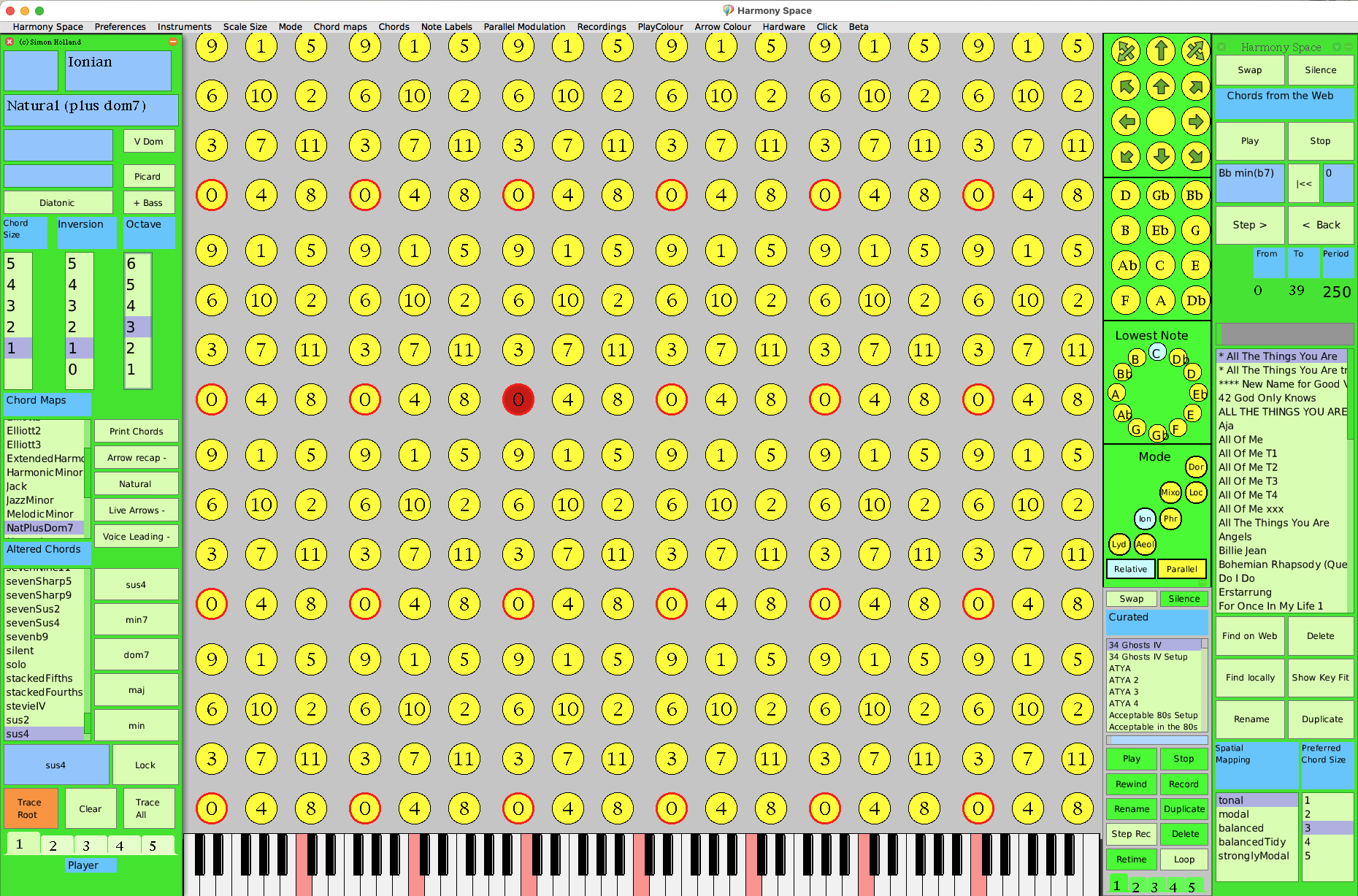Introduction
Harmony is about what happens in music when more than one note is played at once. The ideal way to explore harmony is to play and improvise on any polyphonic instrument – piano or guitar, etc, ideally with other people, playing & modifying different songs & pieces you like, and ideally singing along. But Harmony Space can also help a lot, either by itself, or as part of this kind of mix of activities.
The Elements of Harmony
What are all these circles? (pitch)
Why white notes? (scales)
Filling up like water (chords)
Where is home? (tonal centres)
Simple Movement games
Emerging Chord functions
Jumps as spatial directions (intervals)
Shifting territory (changing key)
Other kinds of home (modal centres)
Learning from pieces you like
How does this song work?
Lessons from 100 songs
Coming up with your own twists and songs
You don’t need to know anything about the theory of harmony to use Harmony Space in diverse interesting ways, but in case you are interested, Harmony Space can also be a good way to learn the theory of harmony, or to get new perspectives if you already know some theory.
What are all these circles ?
(Musical pitch is really two dimensional)
Harmony Space Settings:
Scale size >> 0
Chord size 1
Trace Root on
Note Labels >> semi
Live arrows button off
Preferences >> piano trace >> piano trace ON
If you click on a circle in harmony space with the above settings, a note plays.
What happens if you move horizonally?
The pitches goes up in steps of size four (where a ‘step’ is the smallest possible pitch increase on a piano - known as a semitone)
What happens if you keep going horizontally along a row?
Oh these are just the same notes
So along this whole row there are only just three different notes!
Ok let’s try moving vertically
Ah, we are now going up in steps of size three
So after four notes it’s just the same notes all over again.
So there are only four different notes vertically in each column
So how many different notes are on the screen?
Just twelve!
There are just 12 different notes on the whole screen.
This pattern of 12 playable notes is just repeated on the screen like wallpaper.
But where have all the other notes got to?
Aren’t there a lot more notes on a piano?
Clicking on a circle in the harmony space program plays a note.
Moving along a row, pitches go up in steps of size 4, like this: 0, 4, 8.
Then the pattern just keeps repeating
Moving up a column, pitches go up in steps of size 3, like this: 0, 3, 6.9
Then the pattern just keeps repeating.
This way we get a block of 12 notes ( echoed on the piano keyboard at the bottom).
This layout repeats like wallpaper!
Using the harmony space program,
clicking on any single note circle
you can use the + and - keys
to move the pitch up and down any number of octaves, as seen echoes in the piano keyboard.
In this way, all 88 notes of the piano are accessible.
Using the + and - keys we can flip any note up or down any number of octaves.
The same pitch but an octave higher or lower.
For many, but not all purposes in harmony, these can be considered the same note, and have the same name (this is called octave equivalence by musicians).
Notes in higher octaves are more lightly shaded to represent closeness, and notes in lower octaves are shaded darker to represent distance or depth.
So Harmony Space is not just a flat surface, it is three dimensional, and we can reach all 88 notes on the piano.
Melody is in some ways simple - pitches just go up and down .
But the cognitive psychology and neuroscience of harmony (harmony being about how simultaneous notes interact) strongly suggests that harmony is not one dimensional - it is intrinsically two or three dimensional. As we explore harmony in more depth, the extra dimensions allow a wide range of structures and processes to become apparent.
Harmony Space takes advantage of this to allow diverse properties, concepts, structures, processes and motion of harmony to fall out naturally in ways that children can understand, but which is normally accessible intuitively only to those with strong skills on polyphonic musical instruments (e.g. piano and guitar), and which can normally only be articulated, discussed, shared, analysed and argued about with extensive tertiary level musical training.
There is no practical need to know anything about the theory behind this multi dimensionality, but if you are interested, see <here>.
This illustration is only to give an example of array of 12 notes can span 88 pitches by using the + and - keys (or using the numeric octave panel) to shift some notes by one or more octaves .
For this next screen display, we changed from semitone number labelling to ordinary alphabetic musical labels, using the menu item Note Labels >> alpha.
When represented two dimensionally, many important concepts involved in musical harmony appear as simple spatial relationships. This can avoid having to learn harmony like algebra or latin, and can avoid depending on notations & terminology that are a little muddled after four hundred years of scholarly battles.
Here is one elementary example. In harmony there are several different ways in which musicians consider pitches as being in some sense as close to each other as possible, depending on the purpose. First of all here is the very closest that pitches can get on an instrument such as a piano.
To change pitch by smallest possible steps (semitones) in harmony space one, just moves on the diagonal shown above.
But bass players play a role that is fundamental to the movement of harmony, and for several important harmonic purposes, they think of notes like this (see below) as being as close as you can get. So to move with this kind of closeness, called the circle of fifths, one moves on this diagonal at right angles to semitone closeness.
For reasons that will be explained later, this axis can be called the ‘dominant axis’.
(For this next screen display, we’ve changed from semitone number labelling to ordinary alphabetic musical labels, using the menu item Note Labels >> alpha).
But finally, for many purposes in harmony, called octave equivalence, notes that are an octave apart are treated as the same note, so to move with that kind of closeness, you move on the axis coming perpendicularly out of the screen as seen earlier.
The lowest note singularity (ignore first time round)
If we stay in the plane and don’t move in and out of the screen to change octaves, then all of the 12 notes are in the same octave. That means that at any given time there must a lowest note and a highest note in the plane. This gets set automatically – though you can change it any time using the lowest note panel on the right hand side. Recall that when you move on the semitone diagonal you are moving by the smallest steps in pitch on the 12- note scale. However this is no longer obviously true when you ‘run out of road’ after the highest or lowest note. Then it’s still one step, but played an octave higher or lower. In harmony, for many, though not all purposes, a note shifted up or down by an octave acts as the same note. However, for a singer it’s a very different thing. It is also a very different thing for voice leading and inversion, about which we will learn later.
One last point. Seeing that we can reach 88 notes of the piano from just a single rectangle of notes why does harmony space display repeated redundant extra circles like a wallpaper pattern that just play the same note? Well, as we shall see, when we start looking in detail at how harmony moves in this space, this arrangement will allow a whole range of hidden patterns to emerge visually. <examples>
As explained above, there are really only 12 pitches in this diagram, repeated like a wallpaper pattern (unless you shift octaves) .
So there must always be a lowest and a highest note.
This point is normally set automatically, but can be set anywhere manually using the ‘lowest note’ panel on the left hand side.
Moving on the semitone diagonal, each step is normally a semitone, until one gets to the break point.
The discontinuity can be seen echoes in the piano keyboard.
For many, but not all harmonic purposes, this does not matter





